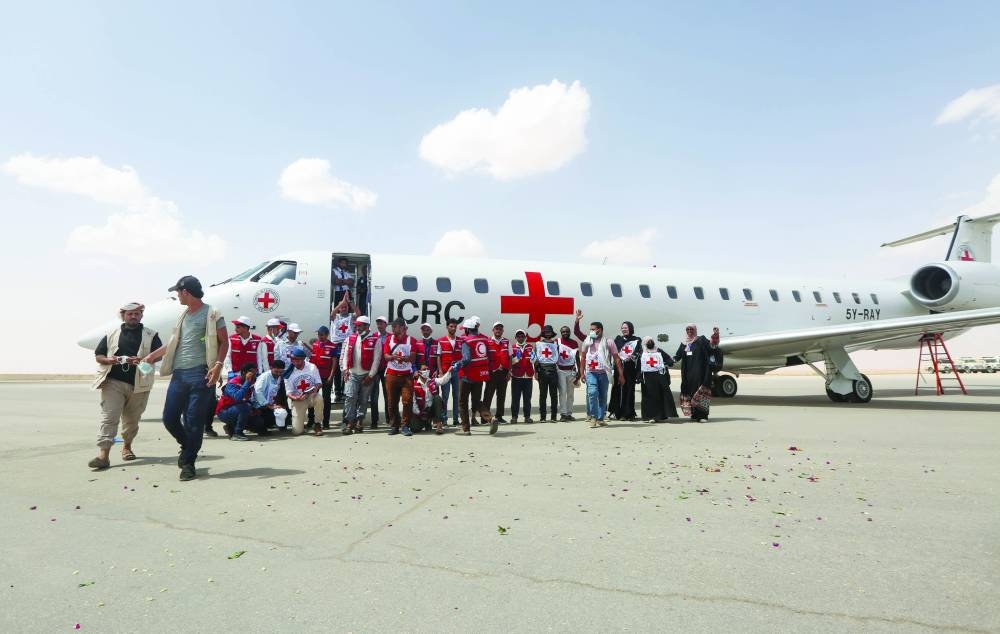Yemeni rebels and government forces freed scores of prisoners yesterday, including a woman, on the last of a three-day exchange of nearly 900 detainees, boosting hopes of ending their protracted war.
Five flights carrying nearly 200 detainees from both sides flew between the Houthi rebel-held capital of Sanaa and the government-controlled northern city of Marib.
The International Committee of the Red Cross (ICRC) said that brought the number of prisoners freed over the three days to 869 under a deal agreed in Switzerland last month.
Among those exchanged yesterday was one woman, Samira March, whom government forces detained five years ago and accused of organising explosions that killed dozens, a government official said, speaking on condition of anonymity.
“She was freed in exchange for the release of journalists held by the Houthis,” government negotiator Majed Fadail confirmed to AFP.
The four journalists had been sentenced to death by the Houthis.
“Let us not forget the real purpose of these releases: reuniting loved ones,” ICRC media adviser Jessica Moussan said.
“These past three days have brought back joy to so many shattered families who have been torn apart by conflict. We only hope more of these releases will happen in the near future.” Some of those released yesterday were taken to the Red Cross aircraft in wheelchairs. Those boarding at Marib were given plastic bags containing food for when the daily Ramadan fast was over.
At the airport in Sanaa, Houthi fighters staged a ceremonial dance with swords to greet their comrades. On Friday, 318 prisoners were transported on four flights between Sanaa and government-controlled Aden, reuniting detainees with their families just before the holiday of Eid al-Fitr.
On Saturday, 357 detainees took flights between the Saudi city of Abha and Sanaa. Saudis were among the prisoners freed.
It is not known how many prisoners each side still has.
The Houthis seized Sanaa in 2014, prompting the Saudi-led intervention the following year. Hundreds of thousands have died in the conflict which triggered a major humanitarian crisis.
A UN-brokered ceasefire that started in April 2022 has sharply reduced casualties. The truce expired in October, but fighting has largely remained on hold.
Marib governorate, an oil-rich region, saw some of the most bitter fighting in the last two years. The city of Marib is the last northern bastion of the government, which is now based in the southern city of Aden. The prisoner exchange, the largest since more than 1,000 prisoners were freed in October 2020, is a confidence-building measure coinciding with an intense diplomatic push to end the war, as it nears its nine-year mark.
Analysts say Saudi Arabia, which leads the military coalition against the Houthis, now accepts that its prolonged military campaign will not defeat the rebel forces.
The exchange and the truce negotiations come a month after heavyweights Saudi Arabia and Iran agreed to re-establish diplomatic ties, sparking a wave of rapprochement across the region.A Saudi delegation has travelled to rebel-held Sanaa to push for a more durable ceasefire.
The delegation left on Thursday without a finalised truce but with plans for more talks that the Saudi foreign ministry said on Saturday would take place “as soon as possible”.
Rebel political chief Mahdi al-Mashat said the next round of talks with Saudi Arabia would start after Eid al-Fitr expected on April 21, Yemen’s Saba news agency reported.
Experts say Riyadh likely seeks security guarantees from Iran, including stopping Houthi drone and missile attacks on its territory.
International
Yemen rebels, government complete prisoner exchange
Yemeni rebels and government forces freed scores of prisoners yesterday, including a woman, on the last of a three-day exchange of nearly 900 detainees, boosting hopes of ending their protracted war.

People stand next to an International Committee of the Red Cross-chartered plane to carry freed prisoners, at Marib Airport, amid a prisoner swap between the two sides in the Yemen conflict, yesterday.
